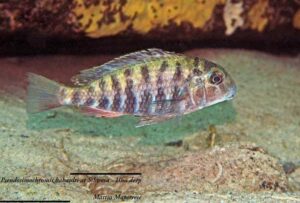Pseudosimochromis
Pseudosimochromis
Pseudosimochromis is a genus of fish belonging to the cichlid family (Cichlidae). These fish are native to Lake Tanganyika in Africa and are known as small to medium-sized cichlids. They can reach a length of approximately 14 centimeters. There are several species within this genus, the boundaries of which sometimes need to be further investigated. They like to live in shallow waters with lots of stones and rocks, where they feed on the algae that grows on them. They are territorial fish that live in pairs or groups and incubate their young in their mouths. They are an interesting choice for aquarists, provided that their specific needs are taken into account, such as a spacious aquarium and the correct water values.
Name and meaning
The genus Pseudosimochromis was described by Nelissen in 1977. The name was carefully chosen and consists of two parts: ‘Pseudo’ and ‘Simochromis’.
Pseudo: This prefix comes from the Greek word “pseudes,” which means “false” or “fake.” It indicates that, although this genus may resemble Simochromis in appearance, this resemblance is deceptive. The only species that was placed in Pseudosimochromis at the time, P. curvifrons, had previously even been classified in the genus Simochromis.
Simochromis: This part of the name comes from the genus Simochromis, which was described by Boulenger in 1898.
The first part, ‘simus’, means ‘snub-nosed’ and refers to the fish’s snout, which ‘descends in a sharp curve’.
The second part, ‘chromis’, is a name that already appeared in Aristotle. It may be derived from ‘chroemo’ (to hum or sing), which originally referred to a drumfish (from the Sciaenidae family) because of its ability to make sound. Later, this term was used more broadly for perch-like fish such as cichlids, damselfish, dwarf sea bass, and wrasse, which were formerly considered to be related. The name ‘chromis’ is often used in the names of African cichlid genera, following Chromis (now Oreochromis) mossambicus.
In summary, Pseudosimochromis means “false Simochromis,” emphasizing both the external resemblance and the taxonomic differences.

Showing the single result
Showing the single result

